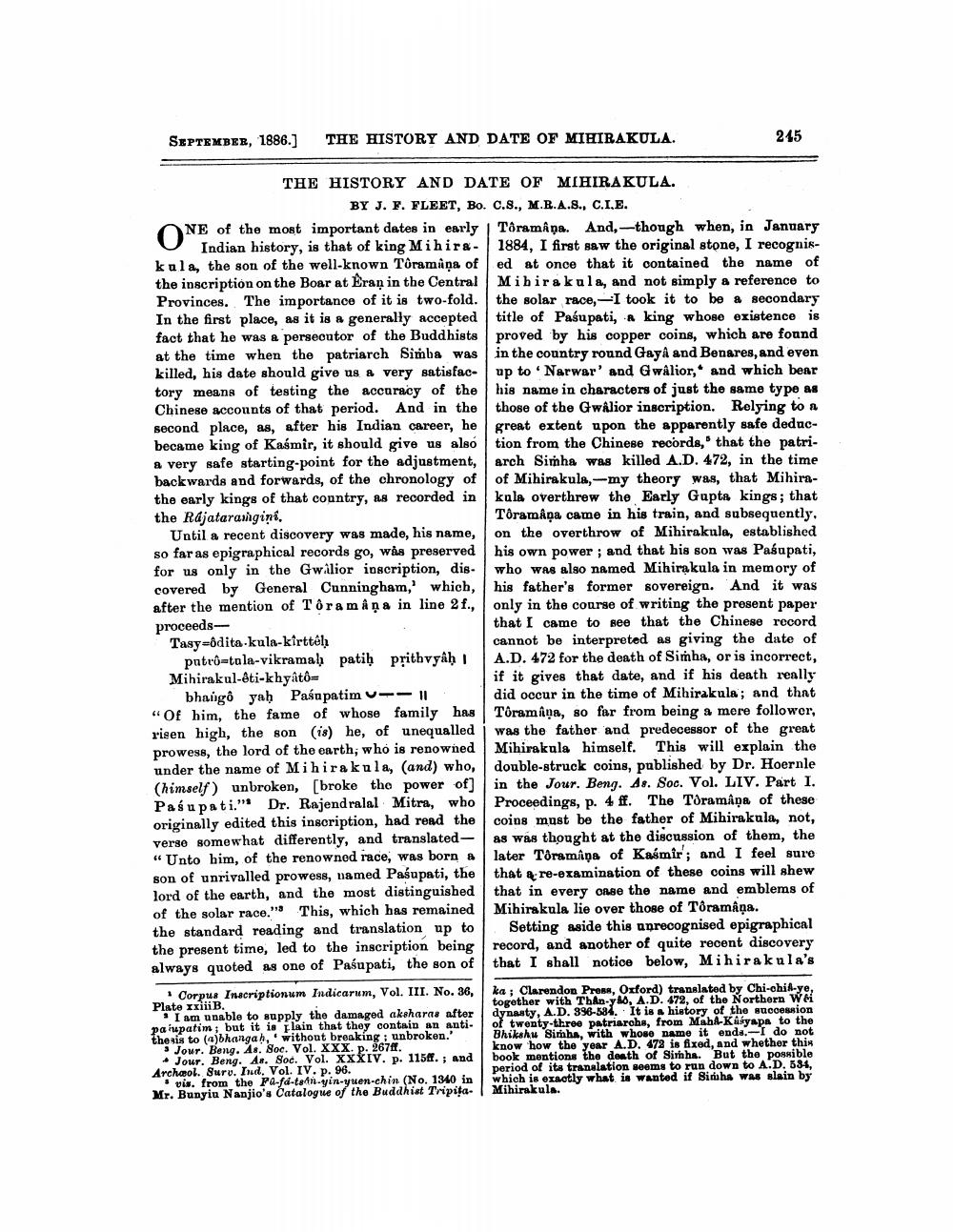________________
SEPTEMBER, 1886.]
THE HISTORY AND DATE OF MIHIRAKULA.
THE HISTORY AND DATE OF MIHIRAKULA. BY J. F. FLEET, Bo. C.S., M.R.A.S., C.I.E.
ONE
NE of the most important dates in early | Tôramâna. And, though when, in January Indian history, is that of king Mihira- 1884, I first saw the original stone, I recogniskula, the son of the well-known Tôramina of ed at once that it contained the name of the inscription on the Boar at Eran in the Central Mihirakula, and not simply a reference to Provinces. The importance of it is two-fold. the solar race,-I took it to be a secondary In the first place, as it is a generally accepted title of Pasupati, a king whose existence is fact that he was a persecutor of the Buddhists proved by his copper coins, which are found at the time when the patriarch Simba was in the country round Gaya and Benares, and even killed, his date should give us a very satisfac- up to Narwar' and Gwalior, and which bear tory means of testing the accuracy of the his name in characters of just the same type as Chinese accounts of that period. And in the those of the Gwalior inscription. Relying to a second place, as, after his Indian career, he great extent upon the apparently safe deducbecame king of Kasmir, it should give us also tion from the Chinese records, that the patria very safe starting-point for the adjustment, arch Simha was killed A.D. 472, in the time backwards and forwards, of the chronology of of Mihirakula,-my theory was, that Mihirathe early kings of that country, as recorded in kula overthrew the Early Gupta kings; that the Rajatarangini. Tôramâna came in his train, and subsequently, on the overthrow of Mihirakula, established his own power; and that his son was Pasupati, who was also named Mihirakula in memory of his father's former sovereign. And it was only in the course of writing the present paper that I came to see that the Chinese record cannot be interpreted as giving the date of A.D. 472 for the death of Simha, or is incorrect, if it gives that date, and if his death really did occur in the time of Mihirakula; and that Tôramâna, so far from being a mere follower, was the father and predecessor of the great Mihirakula himself. This will explain the double-struck coins, published by Dr. Hoernle in the Jour. Beng. As. Soc. Vol. LIV. Part I. Proceedings, p. 4 ff. The Toramana of these coins must be the father of Mihirakula, not, as was thought at the discussion of them, the later Toramana of Kasmir'; and I feel sure that a re-examination of these coins will shew that in every case the name and emblems of Mihirakula lie over those of Tôramâņa.
Setting aside this unrecognised epigraphical record, and another of quite recent discovery that I shall notice below, Mihirakula's
Until a recent discovery was made, his name, so far as epigraphical records go, was preserved for us only in the Gwalior inscription, discovered by General Cunningham,' which, after the mention of Tôramâna in line 2f., proceeds
Tasy-ôdita-kula-kirttel
patel-sala-vikramal pati prithvykḥ Mihirakul-êti-khyâtô=
bhango yah Pasupatim --|| "Of him, the fame of whose family has risen high, the son (is) he, of unequalled prowess, the lord of the earth; who is renowned under the name of Mihirakula, (and) who, (himself) unbroken, [broke the power of] Pasupati." Dr. Rajendralal Mitra, who originally edited this inscription, had read the verse somewhat differently, and translated"Unto him, of the renowned race, was born a son of unrivalled prowess, named Pasupati, the lord of the earth, and the most distinguished of the solar race." This, which has remained the standard reading and translation up to the present time, led to the inscription being always quoted as one of Pasupati, the son of
245
Corpus Inscriptionum Indicarum, Vol. III. No. 36,
Plate xxiiiB. I am unable to supply the damaged aksharas after paupatim; but it is flain that they contain an antithesis to (a)bhangaḥ, without breaking; unbroken."' 3 Jour. Beng. As. Soc. Vol. XXX. p. 267ff.
"
Jour. Beng. As. Soc. Vol. XXXIV. p. 115ff.; and Archeol. Surv. Ind. Vol. IV. p. 96.
vis. from the Fa-fa-ten-yin-yuen-chin (No. 1340 in Mr. Bunyiu Nanjio's Catalogue of the Buddhist Tripita
ka; Clarendon Press, Oxford) translated by Chi-chi-ye, together with Thân-yo, A.D. 472, of the Northern Wei dynasty, A.D. 396-584. It is a history of the succession of twenty-three patriarchs, from Maha-Kasyapa to the Bhikshu Simha, with whose name it ends.-I do not know how the year A.D. 472 is fixed, and whether this book mentions the death of Simha. But the possible period of its translation seems to run down to A.D. 534, which is exactly what is wanted if Simha was slain by Mihirakula.




